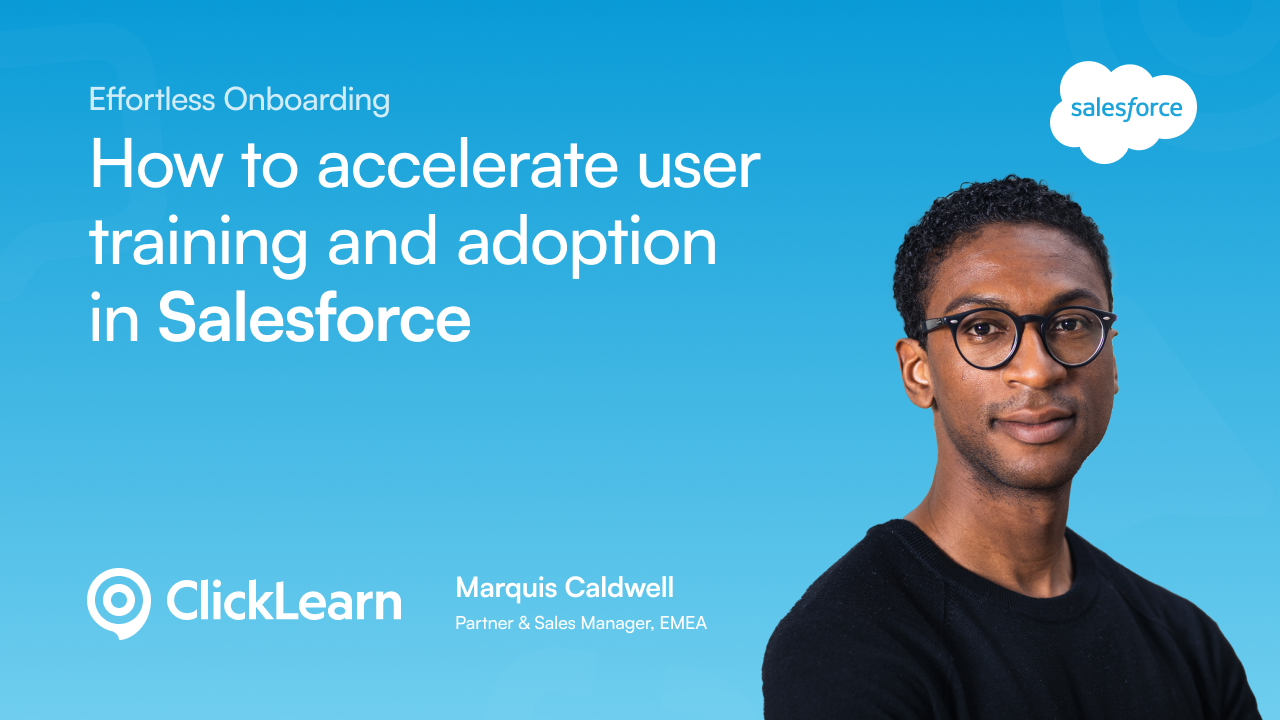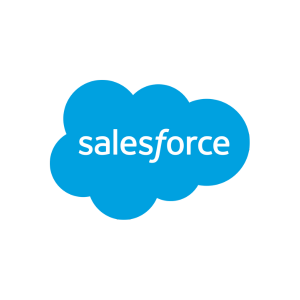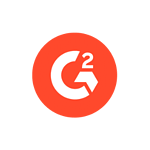Webinar
Effortless Salesforce Onboarding
How to accelerate user training and adoption
Are you facing challenges with Salesforce user adoption, onboarding, or keeping your training materials up-to-date? For Salesforce administrators, ensuring a seamless CRM implementation while staying on schedule can feel overwhelming.
Join this webinar to discover how ClickLearn can simplify your training and onboarding processes, saving valuable time while driving user productivity.
Learn how to create dynamic, multi-format training content tailored to your organization’s needs, deliver real-time AI-driven support, and empower your team to confidently embrace Salesforce.
What you’ll gain:
- Streamline your implementation with a scalable training solution.
- Stay within the project scope by cutting training time in half.
- Provide personalized, role-based guidance to maximize user adoption.





How to succeed in effortless Salesforce onboarding
Onboarding new Salesforce users doesn’t have to be a struggle. With the right strategies, enterprise training managers and Salesforce admins can reduce time-to-productivity and boost user confidence from day one. The key is to take a practical, how-to approach that makes learning Salesforce as easy as using a favorite app. Below we outline actionable steps to achieve scalable, effortless Salesforce onboarding that drives lasting adoption.
1. Accelerate user productivity from day one
Getting employees up to speed quickly in Salesforce is crucial. The faster a user can confidently navigate Salesforce for their daily tasks, the sooner you’ll see real productivity. To accelerate time-to-productivity, focus on just-in-time learning and immediate relevance:
Start with critical tasks: Identify the handful of Salesforce tasks (e.g. logging an opportunity, updating a lead) that are essential to a new user’s role. Provide quick-start guides or short tutorials for these tasks so that newcomers can accomplish key actions on day one.
Bite-sized, hands-on lessons: Instead of lengthy training sessions, use microlearning – brief, focused lessons that let users learn by doing. For example, set up a guided exercise or a safe sandbox simulation for entering a sample sales deal. This builds confidence and muscle memory without overwhelming the user.
Contextual “help” at every step: Ensure that help is easily accessible in the moment of need. This could be tooltips or a help icon within Salesforce that explains fields and steps as the user encounters them. When users know they can quickly get answers within the app, they stay productive and avoid frustration.
By focusing the first phase of Salesforce onboarding on real-world tasks and on-demand assistance, you enable new users to contribute value immediately. They won’t have to pause work to hunt for answers – everything they need to succeed is at their fingertips, which dramatically shortens the learning curve.
2. Prioritize scalable Salesforce onboarding strategies
A major challenge for enterprise training teams is scaling the onboarding process as your user base grows. The goal is to efficiently train 50, 500, or 5,000 users without burning out your trainers or causing inconsistency. Achieve scalable onboarding and adoption by building a program that can reach many users effectively:
Role-based learning paths: Tailor your Salesforce training to specific roles or departments. For example, sales reps get a focused “Salesforce for Sales 101” track, while service agents follow a “Salesforce for Support” path. Role-specific onboarding ensures each user learns features relevant to their job, making training more digestible and relevant. It also prevents overwhelming people with irrelevant information.
Multi-format content delivery: Not everyone learns the same way. Some users prefer watching a demo video, others like step-by-step text instructions or interactive walkthroughs. Provide training content in multiple formats – written guides, videos, slides, and interactive simulations – to cater to diverse learning styles. This boosts comprehension and retention for a wider audience. Modern digital adoption tools make it easy by letting you create a process tutorial once and automatically publish it as a PDF, PowerPoint, video, and more.
On-demand training hub: Create a centralized repository or portal where all Salesforce training materials live. This could be an internal learning portal or knowledge base that’s searchable and available 24/7. An on-demand hub means new hires or current employees can self-serve their training at any time, at their own pace. It also keeps everyone accessing the same up-to-date resources, which is critical as you scale.
By standardizing your onboarding program with reusable content and self-service access, you ensure consistent Salesforce user adoption across the organization. Each new cohort of users gets the same high-quality introduction to Salesforce, without requiring a proportional increase in training effort. Scalable strategies like these free up your trainers to focus on quality and personalization, rather than repeating the basics over and over.
3. Automate your Salesforce training content creation
One practical way to make Salesforce onboarding effortless is to automate the creation and maintenance of training content. Many training managers spend countless hours taking screenshots, writing step-by-step instructions, and updating slides whenever Salesforce changes. Automation can eliminate most of that manual work:
Record once, publish everywhere: Instead of writing training manuals from scratch, use a digital adoption platform or content recorder. Simply walk through the Salesforce process as an expert user would – the tool will automatically capture each step. From that single recording, you can generate multiple outputs: written process documents, slides, and even video tutorials. For example, one recording can instantly produce a Word guide, a PDF, a PowerPoint, plus “show me” videos for demonstrations and interactive “try me” simulations. This one-to-many content generation saves tremendous time and ensures all formats stay consistent.
Easy updates with a click: When Salesforce updates or your business process changes, don’t start over on your documentation. Leverage automation features to replay or update the recorded steps. The platform will refresh screenshots and text in your guides to match the new UI or workflow. This way your training materials are always current without a tedious manual overhaul. Keeping content evergreen is essential for credibility – users trust the documentation when they know it reflects the latest system.
Faster content localization: Enterprises often train users across different regions and languages. Automated tools can expedite translating training content by generating localized versions of screenshots and even voice-over for videos. When you automate training content, you not only speed up creation but also lower the maintenance burden throughout the content’s lifecycle.
By automating Salesforce training content, you dramatically cut down the effort required to produce and sustain learning materials. Trainers can then focus on higher-level tasks like improving learning outcomes, rather than manually updating docs. The result is up-to-date training that keeps pace with Salesforce – delivered with far less labor. In short, automation lets you spend 80% less time on content creation and more time on enabling your team’s success.
4. Empower users with embedded guidance and self-service support
Even after initial training, users will have questions as they start applying Salesforce to real work. Empower your organization’s change management and continuous learning by providing embedded, in-app support that users can access on their own, anytime. By making help readily available inside Salesforce, you encourage people to solve problems within the flow of work instead of submitting support tickets or giving up:
In-app guided walkthroughs: Embed interactive guides directly into Salesforce to lead users through complex processes step by step. For instance, when a user clicks “New Opportunity” for the first time, a guided walkthrough can pop up to highlight where to click and what data to enter at each step. This kind of on-screen coaching lets users learn by doing actual tasks in real time, dramatically reducing confusion. It’s like having a personal tutor inside the software, ensuring no one gets lost even when navigating unfamiliar features.
Contextual help widgets: Add a help panel or chatbot within Salesforce that users can turn to with questions. Modern solutions (including Salesforce’s own in-app help tools and third-party digital adoption apps) allow you to place a self-service support panel in the interface. Users can click “Help” or an AI assistant icon and type questions like “How do I create a report?” to get immediate answers. The assistant can show relevant articles or even walk the user through the steps on screen. Because this help is available exactly when and where the question arises, users feel supported and are less likely to seek outside help or postpone the task.
Embedded knowledge and FAQs: Apart from reactive help, proactively provide on-screen tips and FAQs for common issues. For example, if a user is on the Contacts page, a small tooltip might remind them “Tip: Use Ctrl+S to save quickly” or explain a new field’s purpose. These embedded knowledge nuggets reinforce training continuously. Over time, users become more self-sufficient and comfortable with the system, which is the hallmark of effective Salesforce user adoption.
Empowering users with in-app guidance transforms your Salesforce environment into a self-serve learning platform. New hires and seasoned employees alike can get up to speed on changes or less-used features without waiting for formal training. Importantly, this approach also reduces the support workload on admins and “power users” – with guided help available, there are fewer basic questions coming to your team. Embedded, just-in-time support is a win-win: users feel capable and confident, and your organization benefits from a more proficient, self-reliant user base.
5. Keep training aligned with business goals and system changes
To truly maximize the impact of your Salesforce training, ensure it’s closely aligned with your business objectives and the ever-evolving Salesforce system. This means two things: tying training to desired business outcomes and keeping training content in sync with any changes in Salesforce or your processes.
Align with business outcomes
Always design Salesforce onboarding and training with the end goals in mind. Ask yourself – what business results should effective Salesforce use drive in your organization? Whether it’s increasing sales pipeline, improving customer response times, or enhancing data accuracy, make sure your training highlights how Salesforce helps achieve those outcomes.
For example, if one goal is better data quality, emphasize in training how users should enter complete data and how that data feeds reports for decision-making. When users understand the “why” behind the steps they learn, they’re more motivated to adopt new behaviors. Consider setting success metrics for onboarding (such as 100% of sales reps logging all opportunities) that tie directly to business KPIs. By aligning training with these targets, you turn learning into results – and you can demonstrate training ROI to leadership.
Stay ahead of system changes
Salesforce is not static – new features, updates, and custom process changes roll out regularly. Effective onboarding is not a one-time event but an ongoing effort. To keep user proficiency high, training content must be continuously updated to reflect the current system. Make it a practice that whenever a Salesforce update or a process change occurs, training materials and in-app guidance are refreshed accordingly. Modern training platforms can help by sending out in-app notifications or banners announcing the change to users, along with links to updated tutorials.
For instance, if a new approval step is added to your sales process, you might deploy a brief pop-up in Salesforce saying “New step added to Opportunity Approval – click here to see how it works,” leading to a short guide. This ensures that no one is caught off guard by changes and everyone knows exactly how to proceed. Additionally, use analytics to monitor user engagement with the training content and Salesforce features. If you notice areas where users struggle or skip steps (e.g. many users not completing a certain field), it can signal that additional guidance or clarification is needed. Close the loop by adjusting your training or adding an on-screen tip to address that gap.
By aligning training efforts with business goals and keeping pace with change, you create a Salesforce onboarding program that remains relevant and effective over time. Your training isn’t just theoretical – it directly supports your organization’s success metrics. And as Salesforce evolves, your users evolve with it, thanks to an agile training content strategy. In the end, this alignment drives higher adoption rates, better data quality, and more value from your Salesforce investment.